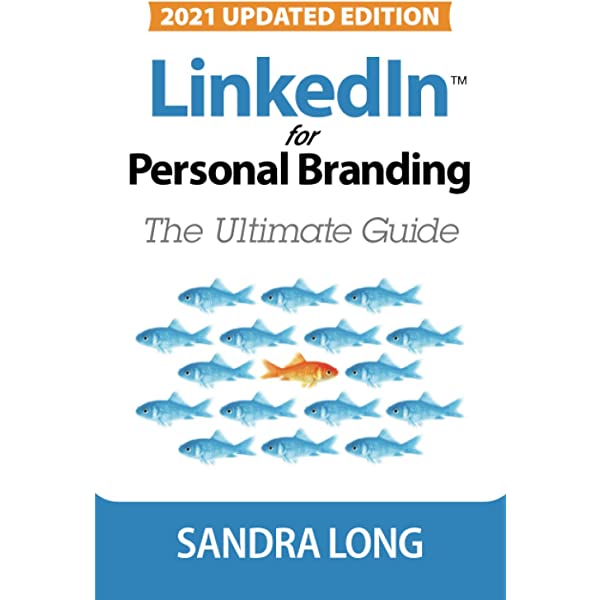
LinkedIn for Personal Branding ถือเป็นอีกหนึ่งวิธีการที่น่าสนใจและดูเป็นมืออาชีพมากสำหรับมนุษย์เงินเดือน ในการสร้างโปรไฟล์ของตนเอง เพื่อเป็นที่ดึงดูดนายจ้าง หรือ บริษัท หรือ โอกาสงานดีๆ
หากคุณเป็นคนที่กำลังมองหางานใหม่ คุณคงคุ้นเคยกับชื่อเว็บไซต์ JobThai หรือ JobBKK เป็นอย่างดี แต่ถ้าลองถามว่าคุณรู้จัก LinkedIn ไหม? พวกเขาหลายคนก็จะส่ายหัวทันทีเลย ทั้งๆ ที่ LinkedIn คือ เครือข่ายในการหางานและฝึกงานบนอินเทอร์เน็ตที่ใหญ่ที่สุดในโลก คุณสามารถเข้าถึง LinkedIn ได้จากทั้งเดสก์ท็อป, แอพมือถือ LinkedIn, ประสบการณ์เว็บบนมือถือ และ แอพมือถือ เรียกได้ว่าหางานทั่วโลกได้จากที่นี่ที่เดียว
“รู้รึเปล่า? 95% ของนายหน้าหรือองค์กร กำลังมองหาผู้สมัครงานบน LinkedIn”
Forbes
LinkedIn for Personal Branding: The Ultimate Guide เป็นหนังสือที่ได้รับการยอมรับว่าเป็นหนังสือขายดีอันดับ 1 ของ Amazon ในปี 2011 ซึ่งหนังสือเล่มนี้ถูกเขียนโดย Sandra Long นักเขียนที่ขายดีที่สุด ผู้เชี่ยวชาญเกี่ยวกับ Linkedln เธอเป็นนักพูด เคยเป็นหัวหน้าฝ่ายขายของ B2B เป็นผู้สอนในองค์กร เป็นที่ปรึกษาในองค์กร และเป็นผู้ก่อตั้งบริษัท Post Road Consulting ซึ่งเป็นบริษัทที่มุ่งเน้นการช่วยเหลือบริษัทต่างๆ ด้วยการกระตุ้นให้บริษัทต่างๆ หันมาใช้ LinkedIn สำหรับการขายและการสรรหาบุคลากรอย่างมีประสิทธิภาพ

หนังสือเล่มนี้ถึงแม้ว่าจะถูกเขียนมานานแล้ว แต่ก็มีการปรับปรุงเนื้อหาและมีเรื่องราวที่น่าสนใจที่วันนี้ แอดมินเลยอยากเอามาเล่าให้พวกเราเหล่ามนุษย์เงินเดือนได้รับรู้กัน จะได้มีเครื่องทุ่นแรงในการหางานดีๆ กันในอนาคต
“ในขณะที่เขียนโปรไฟล์ LinkedIn ให้หาตัวตนที่แท้จริงในด้านที่ดีที่สุดของคุณให้เจอก่อน”
ตราสินค้า มักถูกใช้พูดถึงผลิตภัณฑ์หรืออุตสาหกรรม แต่ในปัจจุบันผู้คนมองว่าตัวเองก็เป็นเหมือนแบรนด์เช่นกัน การจัดการภาพลักษณ์ของตัวเองเป็นเหมือนการสร้างตราสินค้าของแบรนด์ คนเริ่มกำหนดคุณค่าเฉพาะตัวของตัวเองขึ้นเพื่อสร้างความประทับใจให้แก่ผู้ที่มีโอกาสมาเป็นลูกค้า เป็นเจ้านายหรือเป็นผู้ร่วมธุรกิจ ผู้คนใช้ LinkedIn เพื่อสร้างแบรนด์ส่วนตัวขึ้นและเรียนรู้เกี่ยวกับเส้นทางสายอาชีพของผู้อื่น แม้แต่การสร้างความประทับใจแรกให้กับผู้ซื้อ ลูกค้า หรือคู่ค้า ก็สามารถทำได้ผ่านแพลตฟอร์มโซเชียลตัวนี้
“แบรนด์ส่วนบุคคลของคุณ เป็นการผสมผสานระหว่างคุณลักษณะ ทักษะ และคุณภาพส่วนบุคคลของคุณ”
มีประโยชน์หลายอย่างที่คุณสามารถหาได้จาก LinkedIn สำหรับการสร้างแบรนด์ส่วนบุคคลของคุณ ไม่ว่าจะเป็นโอกาสที่ดีกว่าในการเป็นหุ้นส่วนกับผู้อื่น เติบโตในสายอาชีพของตัวเองอย่างรวดเร็ว เพิ่มโอกาสในการขาย การรับสมัคร และการให้คำปรึกษาของคุณ ส่งเสริมความน่าเชื่อถือและการจดจำ และยังช่วยเพิ่มหรือสร้างเครือข่ายของตัวคุณเองได้อีกด้วย สิ่งสำคัญ คือคุณต้องให้ข้อมูลที่ถูกต้องเกี่ยวกับตัวคุณเอง การใช้ LinkedIn จะประสบความสำเร็จก็ต่อเมื่อคุณแสดงให้เห็นถึงจุดแข็งของคุณอย่างสม่ำเสมอและพร้อมที่จะแบ่งปันความเชี่ยวชาญของคุณออกไปเรื่อยๆ
“เลือกใช้รูปภาพและจุดที่โดดเด่นให้เป็น เพื่อสร้างแบรนด์ที่ดี”
ใครก็ตามที่กำลังมองหาโอกาสในการทำงาน ควรมีโปรไฟล์ LinkedIn เนื่องจากการค้นหาชื่อผู้คนใน Google จำนวนมากตรงไปที่นั่น ลูกค้า เพื่อนร่วมงาน และผู้ว่าจ้างงาน สามารถค้นหาผู้หางานได้ง่าย บางสิ่งที่คุณสามารถทำได้เพื่อให้เป็นที่รู้จักใน LinkedIn มีดังต่อไปนี้
- มีโปรไฟล์ที่สมบูรณ์
- ตรวจสอบให้แน่ใจว่าโปรไฟล์ของคุณเป็นแบบสาธารณะและมองเห็นได้
- แสดงชื่อเต็มของคุณ
- ระบุตำแหน่งของคุณ โดยเฉพาะเมืองที่คุณทำงานหรือที่พักอาศัยปัจจุบัน
- มี URL ที่กำหนดเองซึ่งมีชื่อและนามสกุลที่ชัดเจน
- แบ่งปันข้อมูลการติดต่อของคุณไว้ในโปรไฟล์ด้วย
เคล็ดลับอีกอย่างหนึ่ง ก็คือ การเลือกภาษาที่ถูกต้องในการกรอกประวัติ พยายามเขียนให้ดูน่าสนใจ นอกเหนือจากการใช้ภาษาอังกฤษที่ดีแล้ว ควรเพิ่มภาพ เช่น รูปภาพ ลิงก์ และสื่อลงไปด้วย ภาพที่ใช้เป็นโปรไฟล์ควรเป็นภาพที่ดูเป็นมืออาชีพ เช่นภาพคุณยิ้มและสวมชุดที่เหมาะสมกับงานที่คุณทำอยู่ หรืองานที่คุณสนใจจะทำ เป็นต้น
“เพิ่มส่วนต่างๆ ในโปรไฟล์ LinkedIn ของคุณให้มากที่สุด เพื่อแสดงถึงความสำเร็จของคุณและความสำเร็จในอาชีพ”
ในส่วนของประสบการณ์ให้เขียนความเป็นมืออาชีพของคุณเพื่อสร้างความน่าสนใจยิ่งขึ้น คุณสามารถเพิ่มความสนใจในส่วนนี้ด้วยการใช้ภาษาที่ถูกต้อง ลิงก์ รูปภาพ และการนำเสนอต่างๆ รวมถึงชื่อบริษัท สถานที่ วันที่ และคำอธิบายในทุกตำแหน่งที่คุณระบุไว้ในส่วนของประสบการณ์ พยายามมุ่งเน้นไปที่ความสำเร็จมากกว่าความรับผิดชอบที่ผ่านมา นอกจากนี้ควรให้ข้อมูลที่ถูกต้องเกี่ยวกับประวัติของคุณและพิจารณาว่าเรื่องใดเกี่ยวกับประสบการณ์ที่ควรเปิดเผยและเรื่องใดที่ควรเก็บไว้
“เมื่อตัดสินใจเขียนอะไรลงไป ให้นึกถึงผู้ชมทั้งหมดของคุณและโดยเฉพาะอย่างยิ่งผู้ที่มีโอกาสเป็นลูกค้าเป้าหมายของคุณ”
ส่วนของการศึกษาเป็นอีกสิ่งที่คุณต้องทำให้เรียบร้อย ใส่ข้อมูลที่ถูกต้องเกี่ยวกับมหาวิทยาลัยและโรงเรียนมัธยมที่คุณเข้าเรียนรวมถึงสาขาวิชาที่คุณจบมา นอกจากนี้ยังมีส่วนอื่นๆ ที่คุณควรทราบ ได้แก่
- ส่วนกิจกรรม นี่คือส่วนของกิจกรรมคุณเคยได้ร่วมหรือได้ทำ รวมถึงความสนใจ ความคิดเห็น และการแชร์จะถูกแสดงอยู่ นอกจากนี้ยังมีเอกสารยังแสดงเนื้อหาส่วนบุคคลอีกด้วย
- ส่วนองค์กร นี่คือส่วนที่แสดงชื่อบริษัท ตำแหน่ง ระยะเวลาการทำงาน และคำอธิบายโดยย่อของสมาคมวิชาชีพและองค์กรที่คุณเกี่ยวข้องด้วย
- ส่วนภาษา เพิ่มภาษาที่คุณพูดและระดับความสามารถของคุณในส่วนนี้ ส่วนนี้มีความสำคัญสำหรับผู้ที่พูดได้หลายภาษา เนื่องจากนายจ้างมักจะชอบสื่อสารกับบุคคลที่สามารถพูดภาษาแม่ของตัวเองได้
- ใบอนุญาตและใบรับรอง นี่คือที่ที่คุณระบุชื่อหนังสือรับรองของคุณ หน่วยงานรับรอง หมายเลขใบอนุญาต URL ใบรับรอง และวันที่ที่เกี่ยวข้อง
คุณควรกรอกทุกส่วนที่กล่าวมาอย่างถูกต้องและตรงไปตรงมา สิ่งเหล่านี้จะทำให้ข้อมูลในแต่ละส่วนน่าสนใจจนทำให้ไปเตะตานายจ้าง หรือ ลูกค้า ได้อย่างแน่นอน
“ตรวจสอบให้แน่ใจว่าโปรไฟล์ของคุณทำให้คนอื่นคิดว่า “ฉันต้องการทราบข้อมูลเพิ่มเติม!” หรือ “ฉันต้องเจอคนๆ นี้ให้เร็วที่สุด!” หรือ “เราต้องการคนแบบนั้นในทีมของเรา!”
ประเด็นนี้ถือเป็นอีกส่วนสำคัญใน LinkedIn คือ การทำให้โปรไฟล์ของคุณมีเรื่องราวที่ดึงดูดความสนใจของลูกค้าหรืองานที่เหมาะสม เช่น เริ่มต้นด้วบประโยคเปิด หรือย่อหน้าด้วยวิธีการที่คุณจัดการกับปัญหาที่เกิดขึ้นในที่ทำงานเก่าของคุณ การเริ่มเรื่องแบบนี้จะกระตุ้นให้ผู้อ่านติดตามเรื่องราวของคุณอย่างกระตือรือร้น และเขาจะอยากทำงานร่วมกับคุณหรือแนะนำคุณให้เป็นที่รู้จักมากยิ่งขึ้น ใช้เวลาในการรู้เป้าหมายที่คุณต้องการบรรลุและเขียนเรียงความที่ยอดเยี่ยมที่ทำให้คุณแตกต่างจากคนอื่น
สิ่งที่ต้องทำเพื่อทำให้โปรไฟล์ LinkedIn ของคุณน่าสนใจและมีความหมาย
หลังจากกรอกข้อมูลทุกส่วนของ LinkedIn แล้ว คุณควรตรวจสอบขั้นสุดท้ายเพื่อให้แน่ใจว่าข้อมูลทั้งหมดที่ให้มานั้นถูกต้องและดูน่าสนใจ ซึ่งในขั้นตอนนี้ก็มีหลายวิธีดังต่อไปนี้
- ตรวจสอบข้อมูลที่ไม่จำเป็นในประวัติของคุณ อะไรไม่ส่งเสริมหรือไม่สนับสนุนให้คุณดูโดดเด่นก็ให้เอาออก เพราะความชัดเจนและแม่นยำของข้อมูล จะทำให้ผู้อื่นเข้าใจและรู้จักคุณดีขึ้น
- ลบข้อมูลที่เป็นความลับออกให้หมด เพื่อป้องกันไม่ให้เกิดปัญหาในภายหลัง
- ตรวจสอบให้แน่ใจว่าวันที่โปรไฟล์ของคุณ ตรงกับสิ่งที่อยู่ในประวัติย่อของคุณ
- ตรวจสอบการสะกดและไวยากรณ์ของคุณ
- ใช้โทรศัพท์หรือแท็บเล็ตเพื่อดูโปรไฟล์ของคุณและพยายามปรับทุกอย่างที่ดูไม่เป็นมืออาชีพออกไปให้หมด
- พิจารณาความสามารถในการอ่านโดยรวมและลักษณะที่ปรากฏของโปรไฟล์ของคุณเสมอ
- ตรวจสอบให้แน่ใจว่าข้อมูลทั้งหมดถูกต้อง และพิจารณาการใช้สัญลักษณ์และสัญลักษณ์แสดงหัวข้อย่อยเพื่อให้ดูสวยงามยิ่งขึ้น
- ใช้เวลาคิดก่อนเสมอก่อนที่จะโพสต์อะไรในโปรไฟล์ของคุณ เพื่อป้องกันไม่ให้เกิดความขัดแย้งในข้อมูล
- ควรใช้แล็ปท็อปหรือเดสก์ท็อปแทนสมาร์ทโฟนหรือแท็บเล็ต ในการแก้ไขข้อมูลใดๆ ก็ตามในโปรไฟล์ของคุณ
บทสรุป
LinkedIn มีประโยชน์ในหลายๆ ด้าน เช่น การช่วยสร้างความสัมพันธ์ที่มีความหมายกับผู้อื่น และเปิดโอกาสให้ผู้คนสนับสนุนคนอื่น ไม่ว่าจะเป็นเพื่อนร่วมงาน ลูกค้า และผู้ขายของพวกเขา LinkedIn ยังสามารถช่วยให้ผู้หางานติดต่อกับผู้จัดการและนายจ้างที่มีแนวโน้มว่าจะจ้างได้
แต่ในทางตรงกันข้าม LinkedIn ยังมีข้อเสียอีกหลายอย่างที่มาพร้อมกับการใช้แพลตฟอร์มนี้ ยกตัวอย่างเช่น
- ความเสี่ยงของการโจรกรรมข้อมูลกำลังเป็นที่แพร่หลาย เนื่องจากแพลตฟอร์ม LinkedIn กำหนดให้บุคคลต้องแสดงข้อมูลส่วนบุคคลจำนวนมากเพื่อให้ผู้ว่าจ้างที่สนใจได้เห็น
- การใช้แพลตฟอร์มอาจใช้เวลานาน ผู้คนต้องใช้เวลามากมายในการเรียนรู้การใช้ LinkedIn อย่างมีประสิทธิภาพและใช้ประโยชน์สูงสุดจากแพลตฟอร์ม
- แพ็คเกจพรีเมียมของ LinkedIn อาจมีราคาแพง แม้ว่าทุกคนสามารถเข้าร่วมแพลตฟอร์มได้ฟรี แต่คุณจะต้องจ่ายเงินเพื่อเข้าถึงแพ็คเกจพรีเมียม ตัวอย่างเช่น ระดับอาชีพขนาดกลางมีค่าใช้จ่ายประมาณ $29.99 ต่อเดือน ซึ่งอาจมีค่าใช้จ่ายสูงสำหรับผู้เริ่มต้นหรือธุรกิจขนาดกลาง
- แม้แต่มืออาชีพก็อาจไม่ได้รับการยอมรับบนแพลตฟอร์ม คุณต้องใช้งานบน LinkedIn อย่างสม่ำเสมอจึงจะเป็นที่รู้จัก ดังนั้นแม้ว่าคุณจะเป็นผู้เชี่ยวชาญและมีคุณสมบัติครบถ้วน แต่ประวัติของคุณล้าสมัยแล้วและคุณไม่ได้เชื่อมต่อกับผู้อื่น โปรไฟล์ของคุณก็อาจจะไม่มีใครเห็น
แม้ว่าการใช้ LinkedIn จะมีข้อเสีย แต่ก็ยังเป็นแพลตฟอร์มที่ยอดเยี่ยมในการค้นหาและโพสต์งานที่มีอยู่ ประสบการณ์ระดับมืออาชีพ โอกาสในการฝึกงาน และแม้แต่การเข้าร่วมชุมชนมืออาชีพ อย่างไรก็ตามทุกคนควรใช้แพลตฟอร์มด้วยความระมัดระวังและมีความรับผิดชอบ แสดงความคิดเห็นในโพสต์ มีส่วนร่วมในเนื้อหา และตรวจสอบให้แน่ใจว่าโปรไฟล์ของคุณเป็นปัจจุบันเป็นที่รู้จักมากขึ้นและรับประโยชน์สูงสุดจาก LinkedIn







